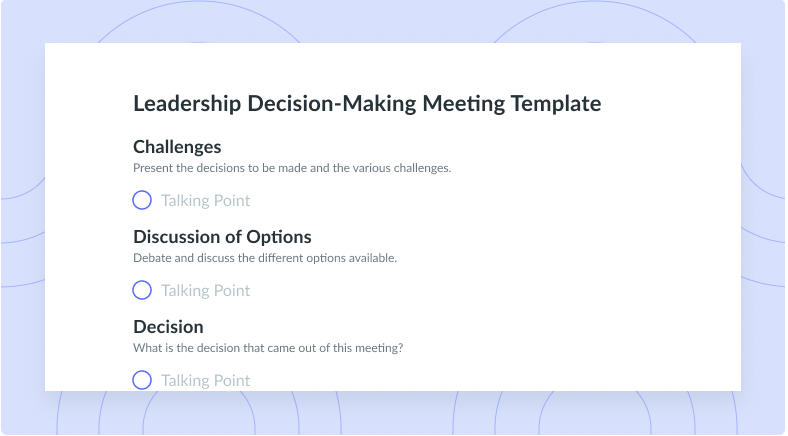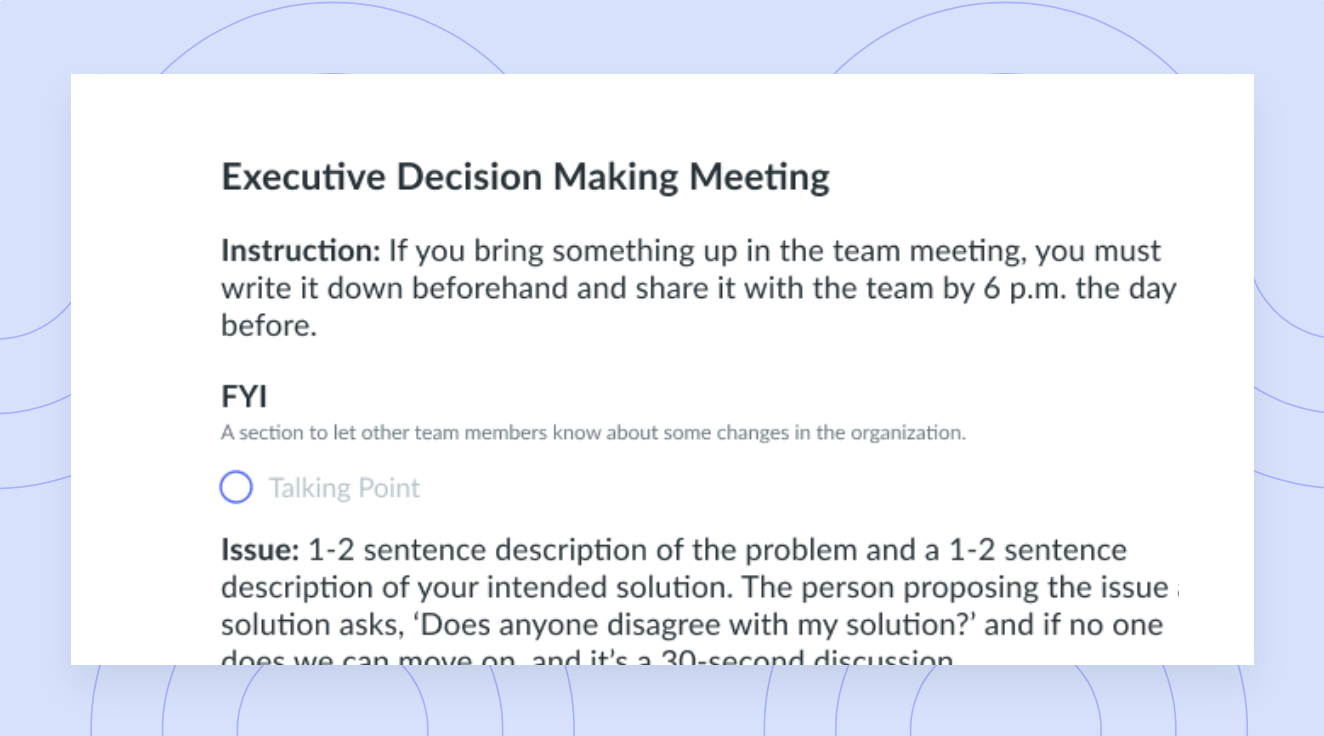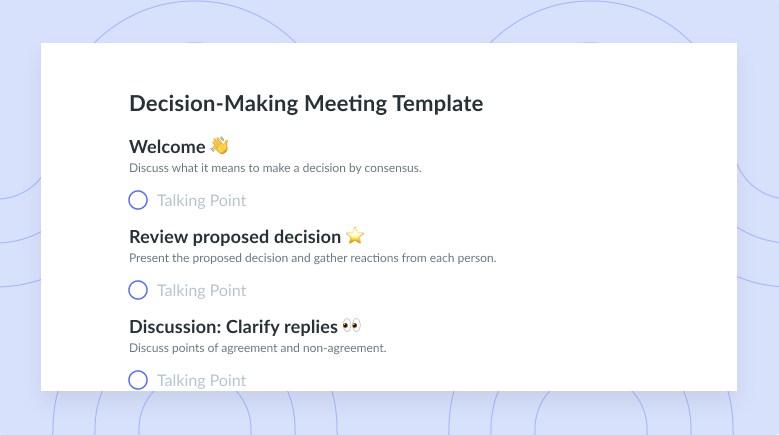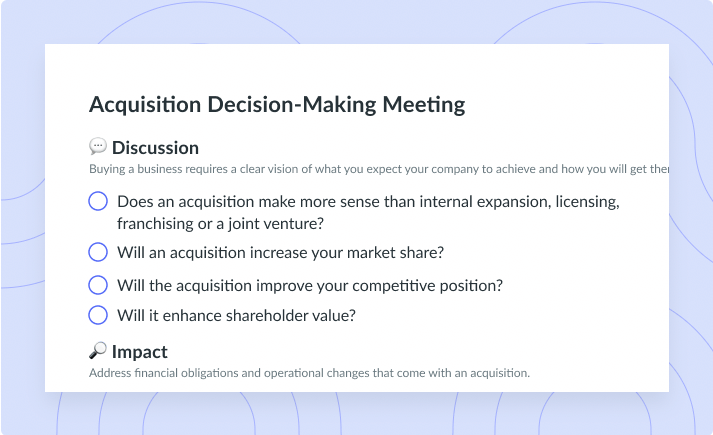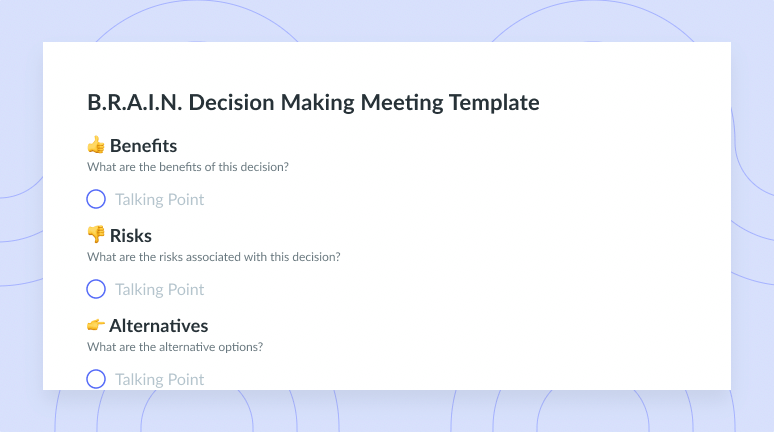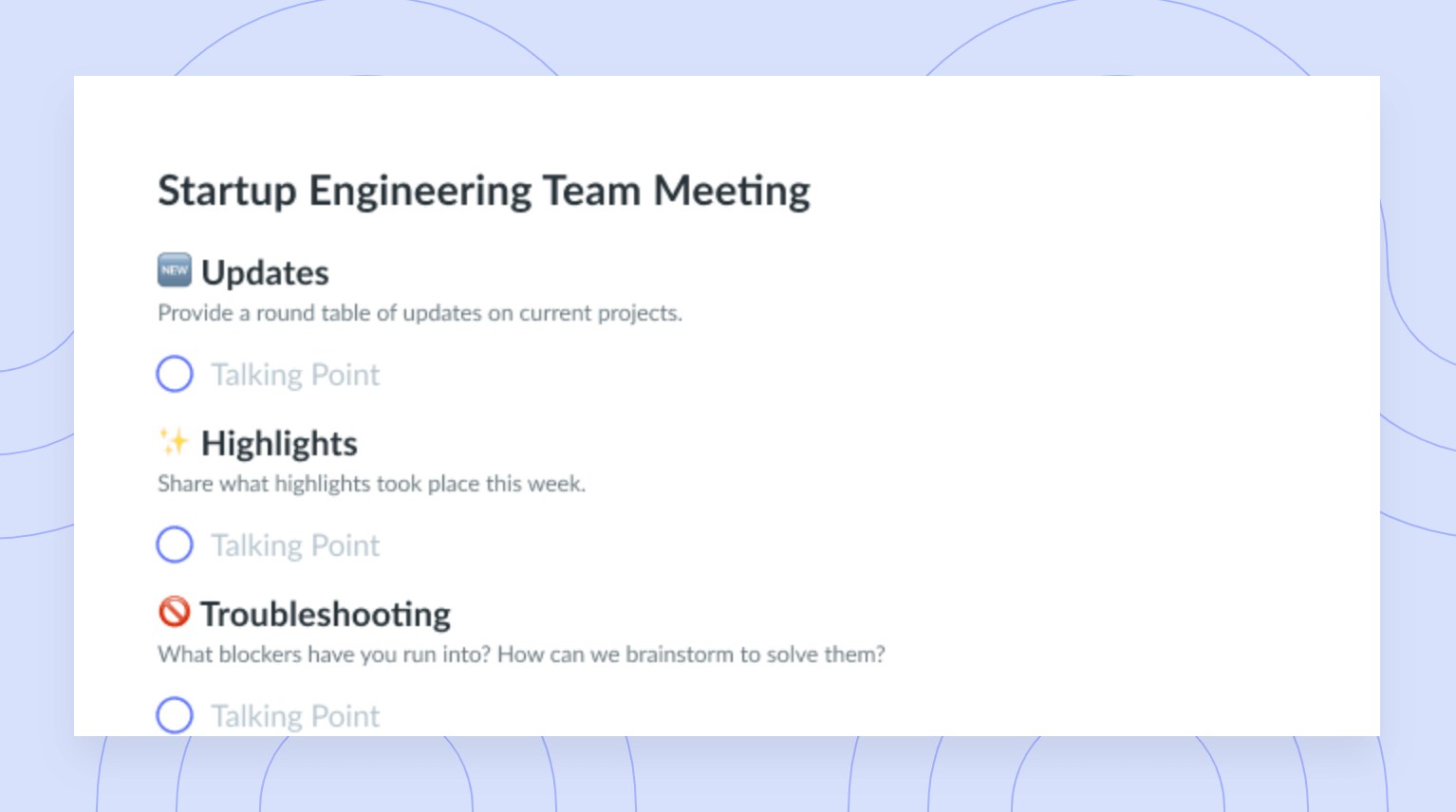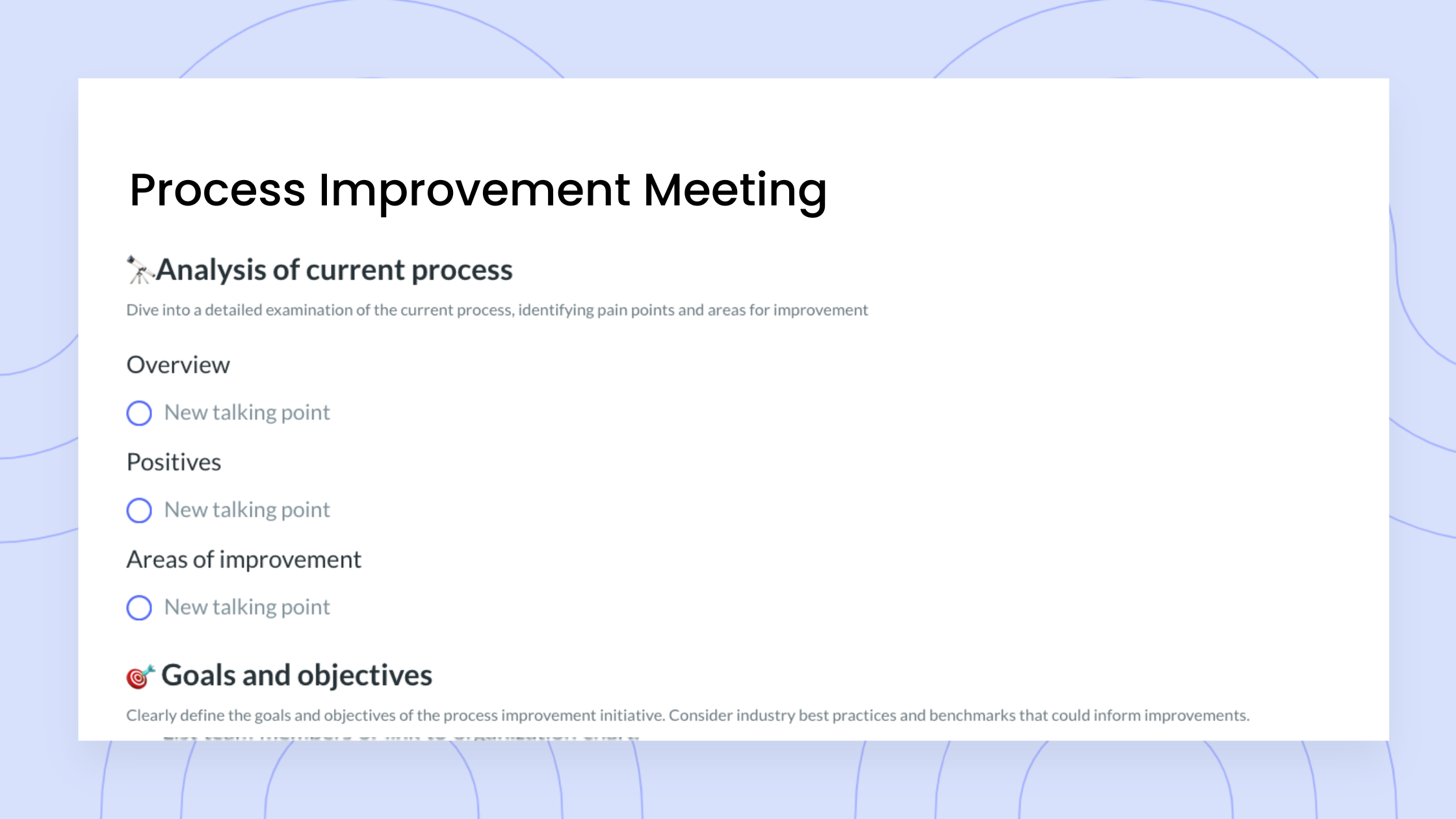Watershed Framework: Fostering Effective Decision Making [+ Free Templates]
Discover how your team can use the watershed framework method to foster effective decision-making. Plus, get free meeting templates!
When was the last time you flexed your decision-making skills and tried a new approach with your team?
If it’s time to develop better strategic decision-making skills, foster better alignment with your team, and come up with solutions that move the team forward, you should consider the watershed framework.
- What is the watershed framework?
- Benefits of the watershed framework
- How to use the watershed framework
- Free decision-making meeting agenda templates
What is the watershed framework?
The watershed framework, also called water-shedding, is a decision-making tool for clarifying the thinking process around every step in making a new decision.
In nature, a watershed is broken down into three parts:
- The roots, where water is heavily absorbed. This is the upper section of a watershed, which has the purpose of storing the bulk of the weight of the water to prevent flooding.
- The tributaries, where water diverges and purifies. This is the middle section, which aims to slow the water down and remove pollutants.
- A lake, where water converges and new life is formed. This is the lower section, which is where opportunities await.
1Upper section
Also known as the “roots,” this section is the foundation and holds most of the weight. Those within this section are responsible for articulating the problem at hand and determining the goal. This section will answer questions like “what pain point are you looking to solve?” and “what is the goal you’re trying to achieve?”.
The employees within this section will also establish and assign priorities to everyone involved, while developing decision criteria before starting. Essentially, those within the upper section are responsible for how the team will make a decision. They form the plan!

Run efficient meetings, come to a decision, and get back to work
Level up your meeting habits to boost engagement and productivity with a collaborative meeting agenda. Try a tool like Fellow!

2Middle section
The middle section is the “tributaries” and will focus on generating and evaluating solutions. The middle section is also responsible for identifying solution tradeoffs to mitigate as much risk as possible. As those in this section create solutions, they consider what realistically can be achieved.
3Lower section
Finally, the lower section, also defined as the “lakes,” focuses on what decision is made and how to share it effectively. Those in the lower section document the critical details around the decision, communicate the details with stakeholders, and consider ways to realign if necessary as new things are learned and considered.
Benefits of the watershed framework
If your team chooses to adopt the watershed framework, there are many benefits that they’ll experience as a result. Namely, the watershed framework:
- Fosters effective problem solving
- Facilitates good communication
- Develops decision criteria for future decision making
- Creates alignment
- Generates solutions
1Fosters effective problem solving
One of the primary benefits of the watershed framework is that it fosters effective problem-solving. Strong problem-solving skills can be especially helpful when the team doesn’t have a very large turnaround window to come up with a solution or when things have to change directions with very little notice.
2Facilitates good communication
Employees in the most effective teams know how to communicate with one another clearly. The watershed framework can facilitate good communication by aligning all team members with how a certain decision was made and how it will be executed moving forward.
3Develops decision criteria for future decision making
Another benefit of the watershed framework is that it allows the team to consider how this decision will potentially help make future decisions easier. Use your knowledge of how the team comes together to solve one problem as a building block to making decisions and actions when new problems arise.
4Creates alignment
When the team has moved into the lake (aka the lower section) of the watershed framework, it means that a decision has been agreed upon and then shared with others. Once this part of the process is complete, details are documented, creating alignment around future decisions.
5Generates solutions
Finally, a benefit to choosing the watershed framework is that it helps all team members generate solutions. When in the tributaries (aka the middle section), team members come together to find solutions that can realistically assist in achieving the goal within the agreed-upon turnaround time. Then, the agreed-upon criteria are used to move these ideas forward.
How to use the watershed framework
If you’re thinking about implementing a watershed framework within your team, here’s how to do so correctly.
- Understand where in the watershed you are
- Know the signs when you’re off track
- Be solution-focused
- Ask thought-provoking questions to generate ideas
- Over-communicate
1Understand where in the watershed you are
No matter what type of decision-making framework your team goes with, it’s always a good idea to know where you are in the process. With the watershed framework, everyone involved needs to pinpoint if they’re in the watershed’s upper, middle, or lower portion.
This can be tricky, as sometimes problems, decisions, goals, and solutions can bleed into each other. Take a step back and hone in on where you are in the watershed to better understand how the team can come together to form a solution.
2Know the signs when you’re off track (and get back on track!)
Things change fast when using decision-making methods—especially the watershed framework. It’s best to know the warning signs that something may be moving off track so you can get back on as soon as possible.
Ask yourself the following questions to know if you’re off track:
- Can I define and explain the goal in a sentence?
- Is the team disagreeing on the most common criteria?
- Are we rushing to make a decision?
- Is the team fixated on a solution before knowing how it’s tied back to the goal?
- Are there too many cooks in the kitchen?
- Is there proper documentation surrounding the goal?
3Be solution-focused
When various team members come together to solve a bottleneck or challenge, it’s easy to lose focus of the primary goal: finding a solution.
If there are too many cooks in the kitchen and too many ideas floating around as options, sometimes the conversation turns from generating an actionable plan to questioning the intentions and goals of the project. The watershed framework can help ensure the team remains focused and zeroed in on possible solutions.
4Ask thought-provoking questions to generate ideas
Because each stage within the watershed framework has specific questions to consider, this decision-making method helps everyone involved ask thought-provoking questions. Since every team has, at one point or another, faced the consequences of a poorly executed plan, asking the team the right questions and coming up with ideas and solutions can help steer everyone involved in the right direction.
Some examples of questions are:
- Is this a problem we encounter often?
- Should we act on this problem now or can it wait?
- Do we have the resources to approach this problem head-on?
5Over-communicate
Coming to a decision is great, but it’s even better to get it off the ground and properly execute it. To make that happen, everyone on the team needs to be aligned on how the team came to the final decision and how it should be executed for it to be a success.
Free decision-making meeting agenda templates
Before you lead your next decision-making meeting, ensure everyone stays on track and set yourself up for the best possible chance of agreeing on a plan of action when you use one of our free meeting agenda templates below.
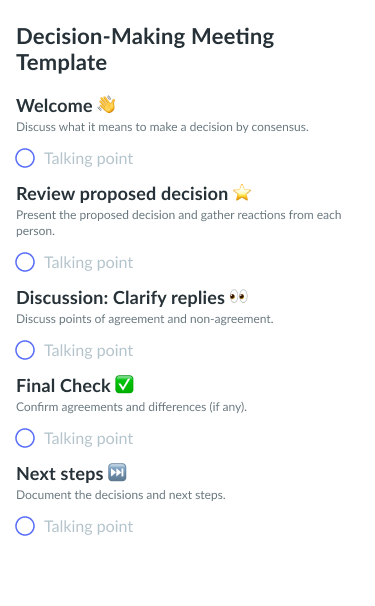
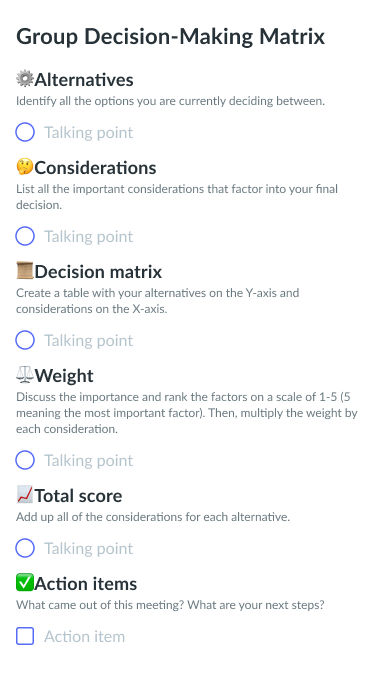

Parting advice
While no decision is perfect, the watershed framework helps teams work together as one, become aligned, and stay focused on the primary goal. You never know what you’ll be able to accomplish, but the watershed framework is sure to flow you in the right direction.

![Fist-to-Five Voting: How to Foster Efficient Decision-Making [+ Free Template]](https://fellow.app/wp-content/uploads/2022/05/Fist-to-five-voting-2.jpg)
![Formal vs. Informal Meetings: What Are the Key Differences? [+ FREE Templates]](https://fellow.app/wp-content/uploads/2022/05/Formal-vs.-Informal-Meetings-2.jpg)


![Choice Overload: 6 Ways to Deal with It [+ Free Templates]](https://fellow.app/wp-content/uploads/2022/07/Choice-Overload-2.jpg)




